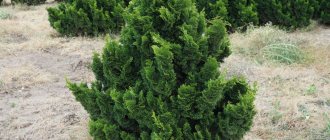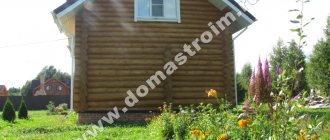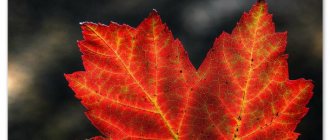- Reports and messages
- Plants
- Maple
Everyone knows such a plant as maple.
It belongs to the Sapindaceae family, woody plants. Today it is considered as a tribe Maple. Included in the horse-chestnut subfamily. The most extensive representation is in Asia, Europe and North America. The overwhelming number of maple species are trees from ten to 40 meters in height. It is most rare to encounter shrubs from five to ten meters in height, with small branches growing from the base of the trunk. These plants are predominantly deciduous.
The node contains two leaves on opposite sides of the stem. Most types of maples have palmate leaves with three to nine veins on the blades.
The flower consists of five petals arranged in symmetry, folded into a tassel, and sometimes an umbrella. Can be green, yellow, red or orange. Usually maples begin to bloom at the very beginning of spring or at the end of winter.
The maple nectary looks like a flattened hoop located between the petals and stamens.
The embryos are called biptera. They consist of two symmetrically located parts, and rotate quickly in flight, distributing seeds over many kilometers. The ripening of the maple fruit occurs no less than two and no more than six weeks after flowering.
A large number of maples are located in the northern part of the Earth. From Europe and North America to Central America and South Asia. Maples are most often found in the temperate zone.
A little less than 20 types of maple grow in our country. Particularly common among them are Norway maple, Tartary maple, Field maple and White maple. For the most part, they grow in the European zone of the Russian Federation and are not found at all in Siberia. Only one maple is represented in the Red Book of Russia - Japanese.
The enemy for these plants is the offspring of Lepidoptera, that is, their larvae that eat maple leaves. Aphids are also a big fan of settling on these trees.
Maples are in high demand in gardening, as well as in the creation of parks, for the beauty of their crown, the unusual color of the bark in winter, and their autumn attire, which is very noticeable in its brightness.
Syrup is obtained from certain types of maple. In spring, maple sap contains sugar, which is extracted in many ways.
The tree of certain types of maple has a decorative wave-like pattern. The raw materials are used in the production of veneer or furniture design. Maple as a material is used in the United States and Canada - sugar and in European countries - white. Maple was used in the manufacture of musical instruments, sports equipment, and stationery.
Description of maple tree
The main feature of maples is their spectacular carved leaves of unusual shape. In most varieties they are palmate, consisting of five lobes. Some species are shamrock-shaped. There are complex leaves, with the number of blades from 3 to 7, in rare cases - nine.
Another feature by which maple is easy to recognize is the lionfish fruit, which helps the plant disperse seeds. Thanks to two symmetrical wings, they begin to rotate when falling, significantly increasing the distance covered.
Light-loving plant. The lifespan varies greatly, depending on the species and conditions, it can reach from 30 to 400 years.
Medicinal properties of maple
The shoots and leaves of Maple are at the same time a choleretic, diuretic and antiseptic.
The well-known Maple juice is used in the treatment of scurvy, atherosclerosis, as well as to strengthen the immune system in case of vitamin deficiency and to restore the nervous system.
A decoction of maple leaves is taken for kidney stones and inflammatory liver diseases.
For deep abrasions, ulcers and cuts, fresh crushed maple leaves will help restore the skin and enhance the effects of antiseptics.
Maple seeds and flowers are a good remedy against intestinal and stomach disorders.
Where does the maple tree grow?
This colorful tree primarily grows in the northern hemisphere: Europe, Asia, North America. The tree's main habitat is temperate latitudes. Only a few species have settled in the tropics; in the Southern Hemisphere, the only one is the Laurel Maple.
In Russia you can find about 20 specimens of the plant.
- In the European part of the country, the following are common: white maple, Norway maple, and Tatarian maple.
- In the Far East, the diversity is much brighter; here you can find: small-leaved maple, Japanese maple, yellow maple, bearded maple, river maple, ash-leaved maple.
- In the Caucasus, other species predominate: alpine, three-lobed.
Chemical composition of maple
The following components can be distinguished in the chemical composition of maple, thanks to which the product has beneficial properties:
- tannins are organic compounds that give the product an astringent taste. This component is capable of killing pathogenic microorganisms, has anti-inflammatory and analgesic effects;
- vitamins A and C, without which not a single process in the human body is possible. These components play the role of antioxidants, preventing the destruction of cell membranes when the biochemical process is disrupted;
- organic acids - allow you to stabilize the metabolic process and prevent the occurrence of alkalosis.
It is important to understand that maple is used only in folk medicine, so its chemical composition has not been well studied.
Characteristics and scope of application
Maple is a favorite plant of landscape designers. It attracts with its elegance, spectacular openwork leaves with an unusual color. The barrel has a smooth surface with increased shine. It is actively used in the design of city parks, recreation areas, and garden plots.
- In addition to its decorative properties, maple is used in furniture production and construction.
- The most popular is Canadian maple, which boasts its high strength characteristics.
- The wood of this tree has excellent wear resistance and has a beautiful shade.
- Due to the numerous species of this tree, the hardness of the wood of each is different.
- Drying wood should not be fast and should not exceed 45 degrees Celsius, otherwise cracks will inevitably appear.
When processed, maple wood bends, glues, polishes, and is treated with dyes and antiseptics.
Certain types of maple are used to make musical instruments, interior items, kitchen utensils, and various crafts. The completed products do not deform, do not warp and last a long time.
The plant is also used in the food industry. Confectioners often use maple syrup when preparing desserts.
names of Maple
The Latin name for this magnificent tree is "Acer", which means "sharp".
The first mentions of Maple appeared in chronicles in the 15th century in the Old Church Slavonic language. Cognate words are found in Polish, Croatian and Scandinavian languages, so it is not possible to accurately judge the roots of the origin of the word.
The Lesny team proposed the following hypothesis for the origin of the name of this tree.
Maple is nothing more than a modified word “Wedge”. Since this fragile-looking tree is stronger than oak in its properties, it was used for splitting stumps and as a wedge. It is quite possible that thanks to these features Maple received its modern name.
Overview of the main types of maple wood
White (Acer pseudoplatanus)
- Its other name is pseudosycamore, obtained due to the similarity of the leaves to the plane tree.
- They are quite large and dark green in color, although some specially bred varieties may have a yellowish, purple or pink tint.
- Prefers mountain forests, but is also found in valleys. Often grown for its fine wood.
- White, with a silky shine, color and excellent wear resistance, it is well suited for the manufacture of musical instruments, furniture and finishing materials.
This species is a popular honey plant. Honey prepared from its nectar has a mild aromatic taste.
Tatarian (Acer tataricum)
Tolerates Siberian frosts and severe drought well. Has decent shade tolerance. It is used in landscaping gardens and parks due to its resistance to industrial emissions and exhaust gases.
Sugar (Acer saccharum)
Native to North America, it grows in the eastern United States and Canada. It is his crimson leaf that is located on the Canadian flag.
- The most famous area of its use is the production of maple syrup, sugar and other sweets based on it. However, sugar maple wood is just as valuable.
- Due to its hardness, strength and heavy weight, it is used in the manufacture of furniture, gun stocks, bowling pins and musical instruments.
- The bark, riddled with deep cracks, is used decoratively.
Holly (Acer platanoides)
The most common species in Russia. Externally, it is very similar to sugar maple.
- Differences between species in the color of juice. The sugar maple has clear sap, while the Norway maple has a milky color.
- The leaves of the tree turn predominantly yellow in autumn.
- The bark is smooth, with small cracks. It tolerates urban conditions well, which is why it is actively used in landscaping gardens and parks.
The wood is quite soft, so it is used in carpentry and the production of furniture parts. It makes great crafts.
This species is one of the excellent honey plants. Only field maple gives the best performance.
Japanese (Acer japonicum)
Famous for its autumn color: carved leaves take on a bright orange color, with the addition of a yellow and scarlet palette.
Having a small size (from 2 to 10 meters in height), the Japanese maple has gained popularity as an ornamental plant, both for private gardens and for urban recreation areas.
It lives in northern Japan and southern Korea. In Russia it is found on Kunashir Island and the South Kuril Islands.
Reproduction methods
Thanks to their lush crown, maple trees are used for landscaping park areas, garden plots, city streets and squares. Almost all varieties easily tolerate transplantation. The topic for practical classes about plant transplantation and propagation should describe the following types of this process:
- using seeds;
- layerings and seedlings.
The seeds of the plant are planted in mid-April in the ground to a depth of 5 to 10 centimeters. If the soil is loose and fertile, the first shoots will appear within 14-21 days.
Reproduction by layering is carried out in the spring. To do this, a shoot is selected, carefully cut and treated with a growth-stimulating solution. The place where the cut was made is delimited by a small stone, moss is placed on it and wrapped in foil or film.
Within a year, a small root appears at the end of the shoot and next spring the shoot can be separated from the main tree. Seedlings require a lot of moisture, so they need to be watered abundantly and often. Under favorable conditions, young trees can grow approximately one meter per year.
Diseases and pests
The most harmful insects are:
- Aphid;
- Scale insects;
- Butterfly caterpillars,
- Gall mite;
- Woodworms, etc.
The tree is susceptible to various diseases and fungi:
- Cancer;
- Powdery mildew;
- Late blight;
- Anthracnose;
- Coral spotting;
- Tar spotting, etc.
Maple sap
A person gets delicious syrup from maple. And when it is condensed using a certain technology to the consistency of butter, the resulting sweetness is tasty and healthy.
But man is not alone in his desire to eat. This juice has long been appreciated by birds and animals. The woodpecker, in order to get to the sweet, makes a hole in the bark with its beak, and the squirrel simply bites through it. This does not harm the tree at all. These wounds are small and heal quickly.
Rules for planting and growing
Planting a maple tree and further caring for it is not difficult and does not include trimming. The tree is undemanding to soil. Planting takes place in spring and autumn.
It is better to shade the young seedling from direct sunlight in summer. The trunk grows straight. The maple crown independently forms into a symmetrical, beautiful shape.
Often shrub types are used as a green hedge, in which case the plant is subjected to formative pruning.
Popular message topics
- Bees, wasps, bumblebees
Our nature is too rich in a wide variety of insects. Its prominent representatives are wasps, bumblebees and bees. What they all have in common is that they have a sting and are yellow and black in color. All these insects strive to pollinate the plant. - The work of the writer Kaverin
The name of Veniamin Kaverin is associated by most readers with his best and most famous work - the novel “Two Captains”. With the motto of the main character of the book “Fight and seek, - Lions
The animal lion is considered the most powerful, strongest and arrogant animal. Because of this, he earned himself the title of king of beasts. The lion is not particularly different, and does not stand out among all predators, yet with its appearance it describes its perfection among
Amazing facts
- Maples are excellent honey plants, which is why they have won the love of beekeepers, who often plant them on their property.
- The maple leaf is depicted on the Canadian flag and has become a true symbol of this country.
- The sap of some maple trees is used to make sweet syrup.
- In Japan and China, the maple leaf is a symbol of love.
- The tree is often mentioned in songs, stories, and poetry.
- The amulet of a dried maple leaf helps to better understand the beauty of nature and open up more widely to all human feelings.
- In the traditions of the Slavs during weddings, the bride’s tree was viburnum, and the groom’s was maple.
Image of Maple
The forest is a rich kingdom with its rulers and subjects. And if such trees as Oak and Cedar are called to be kings, then Maple can rightfully become a joker and a harlequin in their domain.
Smiling widely, juggling with many hands, the Maple tree flares up until it disappears in a brown fire, to be the first to come to life again next year.
Fire Maple has always been a symbol of pure energy, a source of goodness and peace of mind. “Yavor” in Russian scriptures, he brought magic to village fairy tales and epics to the difficult village life.











